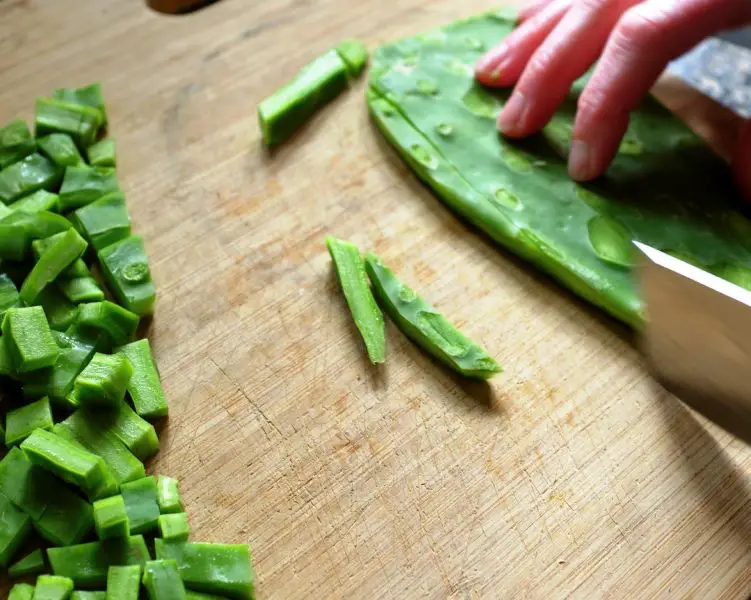When it’s time to spice up your diet, you can’t go wrong with cactus!
Cactus, also called prickly pear, has three edible parts, each with its own unique flavor. You can use the body of the plant–also called the cactus leaf, pad, or “nopales” in Spanish–as a vegetable, fresh or cooked. In spring and summer months, you can enjoy its fruit as a sweet and healthy and dessert. Finally, if you’re lucky enough to catch this plant’s bright flowers in bloom, you can add them to salads, or use them as a festive garnish for desserts and drinks.
Read on to learn all about this delicious plant: how it tastes, what to serve it with, and how to cook cactus for any occasion.
What Does Cactus Taste Like?
Before we learn how to cook cactus, you must be wondering how this unusual ingredient will interact with the other flavors on your plate. Cactus leaves, or nopales, are most commonly used in savory dishes. They are tart, fresh, and herbaceous with a lemony bite, adding an earthy but refreshing dimension to any dish. Some say the flavor is like cooked green beans. Others find they taste more like bell peppers. They’re perfect for vegetarian meals because their texture is thick, hearty and filling, earning them the nickname “green steak.” Nopales are acidic, so they pair well with hearty fats, like Mexican cheese or grilled red meat.

Picture via gardeningknowhow
The flavor of the cactus fruit is more like melon: sweet, but without the tangy bite of citrus. It’s called a cactus pear due to its resemblance in shape and size rather than similarity in taste or texture. Beneath its thick skin, the flesh is juicy, not mealy or grainy. Its flavor is bland enough to pair with lots of breakfast and dessert options, from yogurt and granola to sorbets and baked goods. It can be made into jam, syrup, or juice, mixed into lemonade, or blended into cocktails.
Now that you know what exciting flavors are in store, you must be anxious to learn how to cook cactus for your next meal! But to make the most of this versatile ingredient, you’ll want to ensure it’s properly prepared first, which means thoroughly cleaning it, and removing all of its sharp thorns.
Learn all about cactuses:

Picture via wattersgardencenter
How To Prepare Cactus Leaves
Plenty of experienced chefs have no idea how to cook cactus, mostly because they are afraid to prepare it! The process is easy, though, so long as you’re armed with the right tools. Some markets sell nopales with their spines already removed, which will save you some time. If not, though, you’ll want to protect your hands with kitchen gloves as you shave off the skin and needles with a large knife.
Lay the cactus pad flat on a sturdy cutting board, and be sure to aim the blade away from your body as you work in case the knife catches or slips. Since the narrow edges of the cactus leaf can be especially tough, use a vegetable peeler to remove any thorns that are deeply rooted in the plant. Go over these edges a few times to make sure you don’t miss any!
After the spines are removed, give the cactus pads a thorough rinse. Drain them in a colander, pat dry, or leave them wet if you plan to boil them.
Are you struggling with propagation? This ebook is a how-to guide created for successful propagation. You will find detailed and helpful information for all the propagation methods. It is suitable for you whether you’re just starting with them or ready to advance your knowledge.
How to Cook Cactus Leaves
Nopales contain a lot of fiber, so they can be fairly tough. For this reason, some chefs choose to slice them into thin strips or dice them before cooking. You might opt instead to leave them whole for grilling or boiling, especially if an impressive visual presentation is your goal.
Cactus leaves contain a sticky, sap-like juice that will seep out when they are exposed to heat. If you enjoy this texture, you might choose to cook them for a shorter time and retain some of the juice. If not, though, never fear–it will reduce and evaporate with more time over the fire.
The longer cactus is cooked, the softer it will be. Traditionally, it is served tender, but this is ultimately a matter of personal preference.

Picture by Larisa Blinova
How to Cook Cactus on the Stovetop
Boiling is the simplest way to prepare cactus leaves. Place your nopales, whole or cut, into a pot of cold water without salt. Bring it to a boil; then reduce the heat and cook for approximately twelve minutes. It may take some trial and error to find your sweet spot with this timing. Cook for ten minutes if you prefer your nopales crisp; cook for fifteen minutes or more to achieve a softer texture.
Another easy method is pan searing. All you’ll need is a shallow pan, olive oil, and salt. Coat the pan with oil over high heat; add your diced cactus leaves and mix in salt to taste; cook on high heat until most of the juice has cooked off and the color starts to darken, stirring occasionally; finally, reduce the heat and saute for a
few more minutes until the texture softens. Once finished, this can be served as a side dish or mixed into casseroles, scrambles, salsas, and salads.
How to Cook Cactus in the Oven
If you’re wondering how to cook cactus with a crispy texture, roasting might be the best method for you. Slice the nopales and arrange on a baking sheet while you preheat the oven to 375 degrees. Coat the cactus in oil on both sides. Let them roast for about ten minutes, or until they start to brown on top; then flip them, and roast for another ten minutes. These make a great alternative to chips!
How to Cook Cactus on the Grill
If you want to know how to cook cactus in a truly authentic Mexican style, consider grilling the pads whole. Coat both sides with cooking oil, salt, and pepper. Then pop them onto the grill over medium heat, cooking each side for a few minutes until you see char marks and the color begins to darken. While still warm, top them with Mexican cheese, refried beans, salsa, and, if you’re a carnivore, some grilled meat. Alternatively, you can slice them after grilling and serve drizzled with your favorite sauce or vinaigrette.

Picture via tastewiththeeyes
Experimenting with Cactus
Now that you’ve learned how to cook cactus in several traditional manners, go ahead and get adventurous with it! It doesn’t have to be limited to Mexican style meals. Try substituting nopales in dishes where you would normally use asparagus, green beans, bell peppers, or even okra.
Share these dishes with your family and friends; before you know it, they’ll be begging you to teach them how to cook cactus, too!


